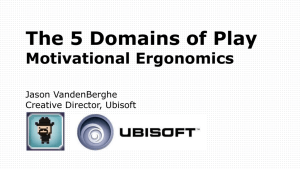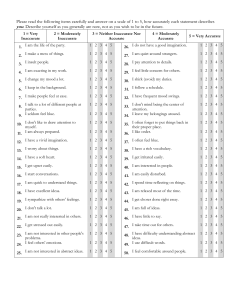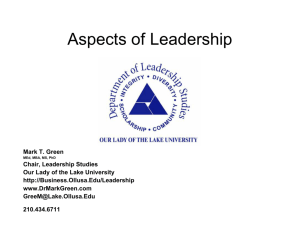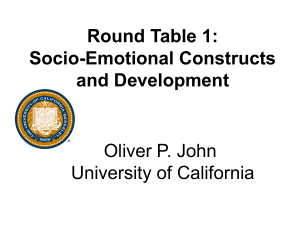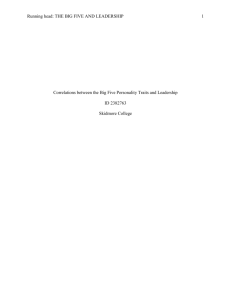Personality factors influencing Individual
advertisement
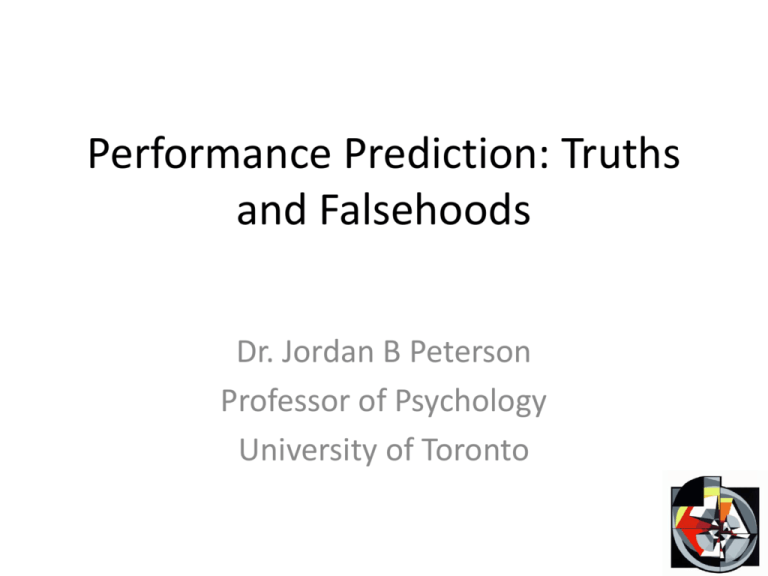
Performance Prediction: Truths and Falsehoods Dr. Jordan B Peterson Professor of Psychology University of Toronto What do psychologists do? • Pursue scientific truth • Pursue careers How to pursue scientific truth • MEASUREMENT – If the phenomenon cannot be measured • It does not exist How to pursue scientific truth, continued • CONSTRUCT VALIDATION – Multimethod, multitrait • Analogous to sensory analysis – Five senses, not one – Plus intrasubjective measurement – Plus technological extension of sensory analysis Use statistics destructively • Aim at demolishing your effect How to pursue a career • Invent a scale (or a construct) – Or rename a scale that already exists • Refuse to validate it – No convergence – No divergence – No criterion – No multimethod, multitrait analysis • Correlate it with some phenomenon How to pursue a career, continued • Publish the paper • Establish a small primate dominance hierarchy – Based on the scale – Climb the hierarchy • Use statistics selectively – Very selectively • Enjoy the fruits of your success! – But seriously distort the knowledge base – And spend your time chasing red herrings NATURE | NEWS FEATURE • Replication studies: Bad copy – In the wake of high-profile controversies, psychologists are facing up to problems with replication. • Ed Yong – 16 May 2012 Things that might not exist • Self-esteem – (neuroticism – extraversion) – 25000 published papers • Whole political and educational agendas • Working memory and EF – IQ? • Emotional intelligence – Agreeableness Things that might not exist • Grit • MacArthur Genius Grant (Angela Duckworth) • Martin Seligman (positive psychology) • Conscientiousness • Optimism/Pessimism – Extraversion/neuroticism • Promotion/prevention – Extraversion/conscientiousness Things that might not exist • Empathy – Measures do not correlate well, but distill to agreeableness • Psychopathy – Agreeableness, negative, minus conscientiousness – Predatory parasite Things that might not exist • Positive illusions – Extraversion, by Taylor’s own analysis • Practical intelligence – Sternberg is a crook • Multiple intelligences – Gardner is a crook Things that might not exist • Any questionnaire measure independent of the Big Five • Any measure of cognitive function independent of IQ • Any behavioral measure of a trait, independent of IQ and the Big Five Things that might exist Individual Differences • Contextual and individual factors – Contextual • Cultural factors • Peer networks • Social support – Individual • Personality • Cognitive ability Personality Traits Measurement Items Employment Variables Economic Value Traits Industriousness Conscientiousness Orderliness STABILITY Volatility (r) Emotional Stability Withdrawal (r) Politeness Agreeableness Compassion Openness Creativity Intellect PLASTICITY Extraversion Assertiveness Enthusiasm Personality • Extraversion – Happiness, optimism, enthusiasm, gregariousness, assertiveness • Neuroticism – .2-.3 with major life outcomes • Particularly anxiety and depression, since that’s what it measures • Agreeableness – Compliance, empathy, maternality, kinship – criminality • Conscientiousness – .4 with major life outcomes • Openness – Creativity, intelligence • Disagreeable/neurotic – Personality disorders • Gender differences – 75% classification accuracy Emotion & Motivation • Extraversion – – • Neuroticism – – • Incentive reward (hope, curiosity, play, enthusiasm)/dopamine Harvest attention/approach and exploit social situations Pain, frustration, disappointment, fear, anxiety/GABA, Serotonin Avoid threat, uncertainty and punishment Agreeableness – – Empathy, sympathy, compliance, CARE (Oxytocin) Form intimate relationships and share • – – • Pursue individual agenda/defend territory People vs things Conscientiousness – – – Orderliness: DISGUST Industriousness: GUILT, SHAME Maintain order • – • Vs Stay uncontaminated and sparkly clean Implement goals Openness – – – – Manipulate abstractions prior to implementation General Cognitive Ability Awe, curiosity Non-social incentive reward/dopamine Models are grounded in motivation Capitalize on social groups Maintain order Measurement Items Measurement • Trait Measures • Big Five Aspect Scale • Unfakeable Big Five • General cognitive ability • Fluid • Crystallized • Dorsolateral prefrontal • Creativity • Creative Achievement Questionnaire • Divergent thinking and fluency (BFAS) Conscientiousness • Industriousness – Waste my time (r) – Always know what I am doing • Orderliness – Am not bothered by disorder (r) – Follow a schedule (BFAS) Emotional Stability • Volatility – Get angry easily – Keep my emotions under control • Withdrawal – Seldom feel blue – Am filled with doubts about things (BFAS) Agreeableness • Politeness – Respect authority – Believe that I am better than others (r) • Compassion – Am not interested in other people’s problems (r) – Take no time for others (r) (BFAS) Openness • Creativity – Believe in the importance of art – Love to reflect on things • Intellect (but see general cognitive ability) – Am quick to understand things – Can handle a lot of information (BFAS) Extraversion • Assertiveness – Take charge – Lack the talent for influencing people (r) • Enthusiasm – Make friends easily – Am hard to get to know (r) Unfakeable Big Five (+) Unfakeable Big Five (-) Cognitive Ability • The complexity of the world – Motivated ends must be met – Modeling of possibility prior to implementation • Models generate solutions to three problems: – Where are you? – Where are you going? – How are you going to get there? – Allows testing and failure • Popper: “Our hypotheses die in our stead” Conceptions of cognitive ability – INTELLIGENCES – Practical vs analytical – Social, emotional, moral – Multiple: linguistic, musical, logical-mathematical, spatial, body-kinesthetic, intrapersonal, interpersonal – INTELLIGENCE – Highest strata has the most explanatory power » “g” measures “success” across broad domains » r ~ .50 Effect Size • Relative magnitude • • • • r= .50 r= .35-.50 r= .15-.35 r< .15 90-97%ile 75-90%ile 25-57%ile 0-25%ile • Binomial – Predictor r = .30 • From 50/50 • To 65/30 – Predictor r = .50 • From 50/50 • To 75/25 • Hemphill, J.F. (2003). Interpreting the magnitudes of correlation coefficients. American Psychologist, 58, 78-8. General Cognitive Ability Creativity Creative Achievement Questionnaire • • • • • • • • • Visual Arts (painting, sculpture) 0. I have no training or talent in this area. 1. I have taken lessons in this area. 2. People comment on my talent in this area. 3. I won one or more prizes at juried art shows. 4. I showed my work in a gallery. 5. I sold a piece of my work. 6. My work was critiqued in local publications. 7. My work was critiqued in national publications. • • • • • • • • • Inventions 0. I do not have recognized talent in this area. 1. I find novel uses for household objects. 2. I sketched out an invention and worked on its design flaws. 3. I created original software for a computer. 4. I built a prototype of one of my designed inventions. 5. I sold an inventions to people I know. 6. I received a patent for one of my inventions. 7. I sold an invention to a manufacturing firm. Employment Variables Innovation Hi/Lo Hi/Hi Entrepreneurial Lo/Lo Rote Tasks Lo/Hi Managerial/Administrative Complexity Who suits which position? • Cognitive ability • High levels of fluid and executive intelligence – Decision making and planning – Research • High levels of retrieval – Creativity and ideational production – Leadership and public speaking • High levels of crystallized intelligence – Information dispensing and storage – Writing and lecturing Who suits which position? • Specific Performance • Openness (r = .30 - .40) – Associated with high levels of creativity/entrepreneurial ability – Extraversion (r = .20) » Managers » Sales People » Leadership – Agreeableness » Lower levels associated with creativity/managerial excellence » Higher levels for public relations, customer service (?) Openness • Complexity and Intelligence • Innovation and Creativity Conscientiousness • Duty and Industriousness • Disgust and Orderliness Employment Variables II • Emotional Stability • High vs Low Stress • Agreeableness • People vs Things • Extraversion • Solitary vs Gregarious Economic Value Complexity and cognitive ability • 95-86 percentile – IQ 130 – 116 • 85-73 percentile – IQ 115-110 • • • • • Attorney, Research Analyst Editor, Advertising Manager Chemist, Engineer, Executive Manager, Trainee, Systems Analyst, Auditor • • • • • • • • • Copywriter, Accountant Manager/Supervisor Sales Manager Sales, Programmer Analyst, Teacher, Adjuster General Manager Purchasing Agent Registered Nurse Sales Account Executive Complexity and cognitive ability • 70-60 percentile – IQ 108-103 • 55-50 percentile – IQ 102-100 • • • • • • • • • • • Administrative Assistant Store Manager, Bookkeeper Credit Clerk. Drafter, Designer Lab Tester/Tech, Assistant Manager General Sales, Telephone Sales Secretary, Accounting Clerk, Medical Debt Collection Computer Operator Customer Service Rep Technician, Automotive Salesman Clerk, Typist • • • • • • • Dispatcher, General Office Police Patrol Officer Receptionist, Cashier General Clerical Inside Sales Clerk, Meter Reader Printer, Teller, Data Entry Electrical Helper Complexity and cognitive ability • 45-42 percentile – IQ 98-95 • 37-21 percentile – IQ 93-87 • • • • • • • Machinist, Food Dept Manager Quality Control Checker Claims Clerk, Driver/Deliveryman Security Guard, Unskilled Labor Maintenance, Machine Operator Arc Welder, Die Setter, Mechanic Medical/Dental Assistant • • • • • • Messenger, Factory Production Assembler, Food Service Worker Nurse’s Aide, Warehouseman Custodian/Janitor Material Handler Packer Economic Value I • Predictive Power • r = .6 to r = .2 – Intelligence – Conscientiousness (managerial) – Openness Creativity (innovative) – Emotional Stability – Agreeableness – Extraversion Economic Value II • Binomial Effect Size • Price’s Law • Economic Impact of Prediction Pareto Distribution Individual variation and productivity prefrontal ability cognitive ability job tryout biographical inventory personality reference check experience interview training/experience ratings academic achievement interest education 0 0.1 0.2 0.3 0.4 0.5 0.6 Economic value and placement – Number of years – Current - Potential Predictor – Job Complexity • High complexity = high variability – Salary • Theoretically proportionate to output • Average output must be 2x salary Process • • • • Advertise Test online Screen Interview best candidates The Founder Institute is the world's largest entrepreneur training and startup launch program, helping aspiring founders across the globe build enduring technology companies. Based in Silicon Valley and with chapters across 35 countries, the Founder Institute has helped launch over 1,112 companies in 5 years. The company's mission is to "Globalize Silicon Valley" and build sustainable startup ecosystems that will create one million new jobs worldwide. • First, only roughly 30% of applicants are accepted to the program. • Then, less than 40% of accepted Founders generally make it through the program to Graduation. • To date, over 20,000 people have applied, and the Founder Institute can predict with 85% accuracy somebody's potential to become a successful technology entrepreneur.

